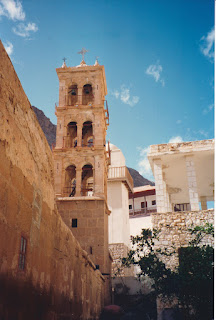A BONE TO PICK – PART III
The unidentified man from the front of the bus joined us while we sipped cardamom-flavored coffee. We chatted about our previous trip to Egypt. He allowed that he was our official minder for the day trip, working for the Egyptian security services. Friendly and talkative, he told us about the cowboy. The border guards didn’t like his looks, no surprise, and decided to work him over. Every time he went through the scanner, he set it off. Piece by piece they made him strip until they reluctently relented after recognizing that it was only the steel-shanks in his cowboy boots setting off the alarm.
We crossed the barren desert to our goal, the ancient monastery of St. Catherine, founded in 325 by Constantine’s mother, St. Helena (who also found the True Cross in the church of the Holy Sepulcher). It was rebuilt in 548 by Justinian as a fortified monastery. An oasis set in the rocks at the foot of Mount of Moses, Jebel Musa, it was a place of peace, with Muslims and Greek Orthodox co-existing. One writer called the area “God-trodden,” and it seemed an apt description of the isolated area. The carved entrance doors made of Cedar of Lebanon have been used by uncounted pilgrims since the sixth century. Inside the grounds is a mosque for the Bedouins along with the famous flourishing green bush. It is said to be a cutting of the original taken from the site where Moses received the Ten Commandments, now the Chapel of the Burning Bush. It isn’t clear what species the Bush is. Some say it is a wild raspberry, others a rose or broom. When there is disagreement about a bush or a castle it is easy to picture all the other intractable disputes over other holy sites.
The basilica’s interior is hung with enormous silver chandeliers laden with yellow beeswax candles, votive lamps surmounted with ostrich eggs suspended from the ceiling and ancient icons of incalculable value, some from the time of the monastery’s founding.
We were sorry to leave and hoped that some day we could return to hike the steep 750 Stairs of Repentance to the top of Jebel Musa to watch a sunrise and repent our sins. But our minder herded us back on the bus for the next big event, “tea with the Bedouins,” a faked tourist attraction but thought-provoking nevertheless with little girls with unkempt hair peeking out from behind rocks to watch us while women stayed out of sight. The girls eventually crept out and joined the boys. After handing out the pens and candies we carried to give to them, we sat in the sand around a small fire, hoping to avoid some disease from dirty water or hands of the men who prepared tea and poured it in smudged glasses while the flat bread baked in the ashes. When their cooking duties were finished, the men lay on the ground propped up on one elbow smoking in front of a cave stocked with provisions including plastic crates for soft drinks, jerry cans and Adidas carry-alls. Rubber sandals were carelessly discarded in the sand. Camels rested some distance away near battered Toyota pickups. A beautiful girl dressed in a blue robe with yellow flowers came out to sell some trinkets. She sat in front of the community grocery store – a little turquoise painted cupboard stocked with a few cans of fish, biscuits and other odds and ends. Camel bags hung on one side of the shop and a dish towel on the other. We wondered what these restless people thought of us staring at them and taking pictures. Outwardly they didn’t seem to care, but inwardly?





